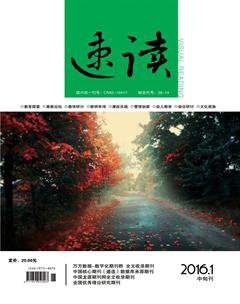Translation Techniques of Reduplicated Words in Chinese Poems
张笑一
摘 要:Reduplicated words are used commonly as the rhetorical devices in ancient Chinese poems. Poets often use reduplicated words to add in the poetry works of rhythm and image in order to render the atmosphere and express feelings. Based on the analysis of common problems in the translation of reduplicated words in Chinese poems, the translation can be divided into two broad categories, the functional equivalence and semantic equivalence.
关键词: reduplicated words; Chinese poems; translation techniques
Chapter 1 Problems with Translation of Reduplicated Words in Chinese Poems
1. 1Ambiguity in Translating Reduplicated Words in Chinese Poems
Reduplicated words can create a common linguistic phenomenon in Chinese ancient poems. It has compact rhythm and a strong expressiveness. Thus, the English translation of reduplicated words is particularly important.
In the process of message transference, different contextual situations may become a limiting factor for the translation of Chinese reduplicated words. A slight carelessness in wording may make the sense either exaggerated or understated. Therefore, ambiguity in translating reduplicated words can be regarded as an avoidable problem of Chinese reduplicated words in ancient poems.
1.2 Loss of Meaning
Without doubt, Chinese reduplicated words, due to its particularity, is very thorny to translate. Although translators can adopt artistic English expressions to achieve similar aesthetic effect, yet sometimes neither forms nor meanings can be truly reproduced, let alone the emotions.
Chapter 2 Techniques in Translating Reduplicated Words in Chinese Poems
In translating the reduplicated words of Chinese ancient poems into English, many kinds of strategies have been proposed. However, in the previous research of other people, the beauty of words is always neglected. To recreate the beauty of reduplicated words, we adopt new skills.
2.1 Functional Equivalence
The translation of reduplicated words in Chinese ancient poems is complex, in general, the problem of translating has always been whether to translate properly. The translation of Chinese reduplication needs careful consideration and systematic study. The first method of translating reduplicated words is the functional equivalence.
2.1.1 Repetition
Repetition, as a common figure of speech in English, can express strong emotions and form beautiful rhythm, thus reaching the same rhetorical effect. Repetition linked by conjunctions is usually adopted when the reduplicated words denote coordinate things or continuous actions or states. The conjunction, in most cases refers to“ and”. The following translation offers a convincing example to this point:
重重叠叠上瑶台,几度呼童扫不开。(苏轼《花影》 )
Layer upon layer they appear on the marble terrance;the boy has been told to remove them several times.
Therefore, repetition may also be linked by punctuations to give the readers direct and fluent feelings just like English reduplicated words. In addition, it makes effect of emphasis so as to strengthen the meanings. Usually, such repetitive patterns are linked by comma or hyphen marks.
2.1.2 Phonetic rhetoric
Phonetic rhetoric is another effective method that plays an important role in the translation of Chinese reduplicated words in ancient poems. The commonly phonetic rhetoric devices in English are onomatopoeia and alliteration etc.
The first one is onomatopoeia. “ The word onomatopoeia means the use of words that sound like what they refer to in real life. This figure of speech is used to stimulate the readers sense of hearing and make me feel as if they were hearing the very sounds presented by the words”.
Alliteration is another kind of phonetic rhetoric. It is frequently used in poetry and, to a lesser degree, in prose in order to establish a link between words. Similarly to reduplication, alliteration sounds also rather rhythmical, which can output the aesthetic effect of Chinese reduplicated words in another way.
2.2 Semantic Equivalence
As we all know, Chinese reduplicated words are far more than English reduplicated words. Thus sometimes its difficult to find related English reduplicated words when translating. At this point, we can make an analysis of source words in the view of semantics.
2.2.1Usage of adjectives and adverbs
In general, adjectives and adverbs in Chinese reduplicated words mean very meaning of the original words for emphasis. So English words are available to express the meaning. There are the following examples.
硬梆梆——very stiff
静悄悄——perfectly quiet
It is an emphatic expression, which is frequently used in translating reduplicated adjectives to strengthen the extent of the state or actions, thus making the description concrete and accurate.
2.2.2Usage of quantifiers
Specific quantifiers are adopted to serve the propose of meaning augment or meaning strengthening. The transformation of message is mainly realized through boosting up the energy in language. Such kinds of quantifiers mainly include “each”, “every” and “all” with the examples respectively shown below:
军书十二卷,卷卷有爷名。
The roster consists of many muster rolls,
And every roll has fathers name on it.
We can see we often use some specific quantifiers when translating the reduplicated words in ancient poems. Abandonment of reduplicated form can also be another way in translating the ancient poems to convey the original meaning according to different context and meanings.
Conclusion
When we translate Chinese reduplicated words into English, we should bear overall point in mind and put the meaning of reduplicated words integrated into the specific context. In this sense, it is truly necessary to make a comprehensive research on the translation of Chinese reduplicated words.
First, the paper makes a brief introduction of Chinese reduplicated words. Then the focus is on the recent problems of translating reduplicated words in ancient poems. Finally, this paper analyses two kinds of strategies of translation including functional equivalence and semantic equivalence. Due to the wide use of reduplicated words in Chinese literature works, the proper translation of these words is the key in developing Chinese culture. In this sense, this paper has its practical significance.

